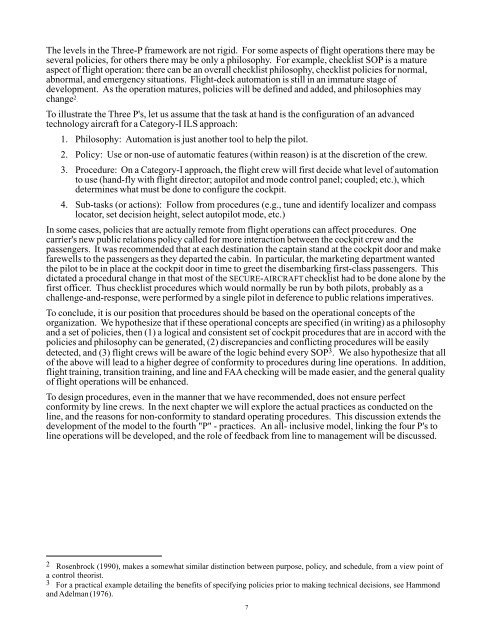On the Design of Flight-Deck Procedures - Intelligent Systems ...
On the Design of Flight-Deck Procedures - Intelligent Systems ...
On the Design of Flight-Deck Procedures - Intelligent Systems ...
You also want an ePaper? Increase the reach of your titles
YUMPU automatically turns print PDFs into web optimized ePapers that Google loves.
The levels in <strong>the</strong> Three-P framework are not rigid. For some aspects <strong>of</strong> flight operations <strong>the</strong>re may beseveral policies, for o<strong>the</strong>rs <strong>the</strong>re may be only a philosophy. For example, checklist SOP is a matureaspect <strong>of</strong> flight operation: <strong>the</strong>re can be an overall checklist philosophy, checklist policies for normal,abnormal, and emergency situations. <strong>Flight</strong>-deck automation is still in an immature stage <strong>of</strong>development. As <strong>the</strong> operation matures, policies will be defined and added, and philosophies maychange 2 .To illustrate <strong>the</strong> Three P's, let us assume that <strong>the</strong> task at hand is <strong>the</strong> configuration <strong>of</strong> an advancedtechnology aircraft for a Category-I ILS approach:1. Philosophy: Automation is just ano<strong>the</strong>r tool to help <strong>the</strong> pilot.2. Policy: Use or non-use <strong>of</strong> automatic features (within reason) is at <strong>the</strong> discretion <strong>of</strong> <strong>the</strong> crew.3. Procedure: <strong>On</strong> a Category-I approach, <strong>the</strong> flight crew will first decide what level <strong>of</strong> automationto use (hand-fly with flight director; autopilot and mode control panel; coupled; etc.), whichdetermines what must be done to configure <strong>the</strong> cockpit.4. Sub-tasks (or actions): Follow from procedures (e.g., tune and identify localizer and compasslocator, set decision height, select autopilot mode, etc.)In some cases, policies that are actually remote from flight operations can affect procedures. <strong>On</strong>ecarrier's new public relations policy called for more interaction between <strong>the</strong> cockpit crew and <strong>the</strong>passengers. It was recommended that at each destination <strong>the</strong> captain stand at <strong>the</strong> cockpit door and makefarewells to <strong>the</strong> passengers as <strong>the</strong>y departed <strong>the</strong> cabin. In particular, <strong>the</strong> marketing department wanted<strong>the</strong> pilot to be in place at <strong>the</strong> cockpit door in time to greet <strong>the</strong> disembarking first-class passengers. Thisdictated a procedural change in that most <strong>of</strong> <strong>the</strong> SECURE-AIRCRAFTchecklist had to be done alone by <strong>the</strong>first <strong>of</strong>ficer. Thus checklist procedures which would normally be run by both pilots, probably as achallenge-and-response, were performed by a single pilot in deference to public relations imperatives.To conclude, it is our position that procedures should be based on <strong>the</strong> operational concepts <strong>of</strong> <strong>the</strong>organization. We hypo<strong>the</strong>size that if <strong>the</strong>se operational concepts are specified (in writing) as a philosophyand a set <strong>of</strong> policies, <strong>the</strong>n (1) a logical and consistent set <strong>of</strong> cockpit procedures that are in accord with <strong>the</strong>policies and philosophy can be generated, (2) discrepancies and conflicting procedures will be easilydetected, and (3) flight crews will be aware <strong>of</strong> <strong>the</strong> logic behind every SOP 3 . We also hypo<strong>the</strong>size that all<strong>of</strong> <strong>the</strong> above will lead to a higher degree <strong>of</strong> conformity to procedures during line operations. In addition,flight training, transition training, and line and FAA checking will be made easier, and <strong>the</strong> general quality<strong>of</strong> flight operations will be enhanced.To design procedures, even in <strong>the</strong> manner that we have recommended, does not ensure perfectconformity by line crews. In <strong>the</strong> next chapter we will explore <strong>the</strong> actual practices as conducted on <strong>the</strong>line, and <strong>the</strong> reasons for non-conformity to standard operating procedures. This discussion extends <strong>the</strong>development <strong>of</strong> <strong>the</strong> model to <strong>the</strong> fourth "P" - practices. An all- inclusive model, linking <strong>the</strong> four P's toline operations will be developed, and <strong>the</strong> role <strong>of</strong> feedback from line to management will be discussed.2 Rosenbrock (1990), makes a somewhat similar distinction between purpose, policy, and schedule, from a view point <strong>of</strong>a control <strong>the</strong>orist.3 For a practical example detailing <strong>the</strong> benefits <strong>of</strong> specifying policies prior to making technical decisions, see Hammondand Adelman (1976).7
















